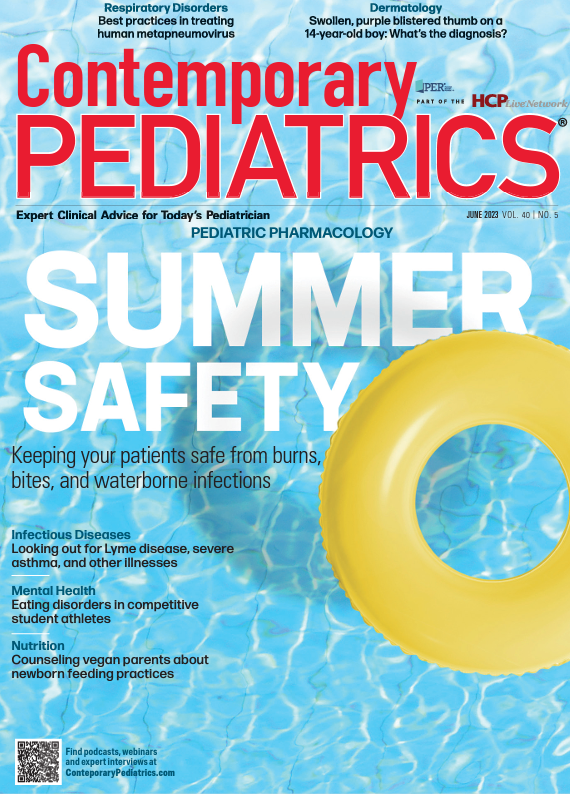AAP: Tips for teaching children about body boundaries and safety
Not forcing affection, using appropriate language, and controlling media exposure are just some of the American Academy of Pediatrics’ tips for teaching children about body boundaries and safety.
Child holding up hand with the word "STOP" | Image Credit: © motortion - © motortion - stock.adobe.com.

According to a recent news release from the American Academy of Pediatrics (AAP), 1 in 3 females and 1 in 20 males will experience sexual assault or abuse by the age of 17 years. Child Abuse Prevention Month is April, and the AAP has several tips for parents to provide information to help them recognize unsafe situations.
“Children and teens who feel in control of their bodies are less likely to fall prey to sexual abusers,” said Shalon Nienow, MD, FAAP. “And if they do suffer abuse, they are more likely to tell a trusted adult—which can make all the difference in stopping the events and subsequently helping them recover from this painful experience.”
1. Use appropriate language:
Teaching children proper names for all their body parts, including their genitals, could give them the impression they are bad or are a secret and can’t be talked about. Designating these parts, covered by their swimsuits and their mouths, as “private,” is good practice. The child knows these places should not be touched or looked at without permission, according to the AAP.
2. Evaluate family respect for modesty:
Parents can teach younger children to give older siblings their privacy when it is requested. Laying a foundation for future discussions and models for good social behavior can help a young children grasp the concept of modesty.
3. Do not force affection:
Parents can teach their children other ways to show affection that differ from forced and guilt-related hugs or kisses, such as high-fives or a thumbs up. This can reinforce a child’s body is theirs to control, a concept called autonomy. The AAP states it is OK to tell even grandparents that they do not want to give them a kiss or hug goodbye.
4. Explain “OK touches” and “not-OK touches”:
A way for people to show they care for and help one another, such as when caregivers help with bathing or toileting, is an “OK touch.” Parents can reassure children that most touches are “OK touches.” A “not OK touch” is a one that has anything to do with private parts, hurts them, makes them feel uncomfortable, scared, confused or one they don’t like.
5. Reinforce that people should respect each other:
The AAP recommends discussing that it is never OK for anyone to look at or touch private parts without permission. Children should also be taught not to look at or touch other people’s bodies without their permission as well.
6. Give a solid rule about inappropriate touches:
The AAP states it is easy for a child to understand the concept of a rule, which can make it easier for them to recognize a “not OK touch” if one ever happens. A solid rule base can empower the child to say no to these types of touches.
7. Remind children to tell trusted grown-ups of “not OK touches”:
Parents can reassure children that they will listen to them if the children talk about “not-OK touches.” Inappropriate touching, especially from a trusted adult, can be confusing for children.
8. Control media exposure:
A recommendation regarding media exposure is to create a family media plan. Parents should understand rating systems of movies, television shows, and video games, and use parental controls that are available through many internet, cellular, cable, and satellite providers. Appropriate alternatives are an important part of avoiding exposure to sexual content in the media, according to the news release. Parents should be advised that their child could see adult sexual behaviors on screens or in person and may not mention them.
9. Review information with children regularly:
The AAP states that good times to discuss these tips with children could be during bath time, bedtime, doctor visits and before a new situation. Every day, children interact with different adults at childcare facilities, sports events or practices, dance classes, camps, and at after-school programs among other locations. Giving them tools to recognize and respond to uncomfortable situations is crucial.
10. Expect questions:
Parents should know that it is always important to tell the truth to children. Questions children ask and the answers that are appropriate to give will depend on the child’s age and ability to understand these tips.
“Help [children] understand that they will not be in trouble for telling [parents] about information that should not be kept secret,” Nienow said. “Empower them to tell another trusted adult if they are too uncomfortable tell [their parent]… Always let your child know that you believe in them and will do everything you can to protect them from harm.”
Reference:
10 tips for parents to teach children about body safety and boundaries. American Academy of Pediatrics. April 11, 2023. Accessed April 21, 2023. https://www.aap.org/en/news-room/news-releases/health--safety-tips/10-tips-for-parents-to-teach-children-about-body-safety-and-boundaries/

Quiz: Recommendations for influenza control in children from the American Academy of Pediatrics
February 1st 2024Take this quiz and test your knowledge of the American Academy of Pediatrics' recommendations for routine use of influenza vaccines, medications for the prevention and treatment of pediatric influenza.